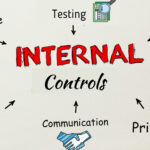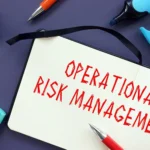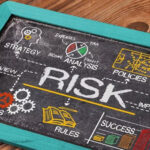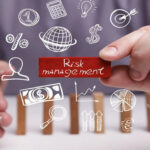Explore how the Digital Knowledge Operations™ (DKO™) framework transforms enterprise risk management for financial institutions. Learn how DKO helps design, implement, and monitor an effective Enterprise Risk Management Framework (ERMF) to manage risks efficiently. The blog covers key components of ERMF, including risk identification, assessment, response, and monitoring, and showcases how DKO's pragmatic approach ensures robust risk management.
Financial institutions operate in an environment fraught with uncertainties, from market volatility to regulatory changes. Establishing a comprehensive Enterprise Risk Management (ERM) framework is imperative to navigate these challenges effectively.
This article delves into the four pivotal components that form the backbone of a resilient ERM framework, ensuring institutions are well-prepared to identify, assess, and mitigate potential risks.
What is Enterprise Risk Management Framework (EMRF)?
An enterprise risk management framework (ERMF) is a template or guideline that enables a systematic approach to identify, analyze, and mitigate risks or prepare for potential internal and external business risks.
ERMF helps financial institutions with fundamental guidance to design, implement, monitor, review, and improve risk management across all levels. This guidance is vital to address the risks and minimize or nullify their reputational and financial impact.
Components of an Effective Enterprise Risk Management Framework
A well-designed Enterprise risk management framework helps a bank’s board of directors and senior management customize their business needs and analyze the amount of risk exposure, risk appetite, and risk controls. Fundamentally, an ERMF consists of four key components:
1. Risk Identification – A Crucial Component of Enterprise Risk Management Framework
Risk identification is one of the most crucial components of an enterprise risk management framework. It forms the foundation for developing an effective and robust enterprise risk management strategy.
This includes identifying and generating a comprehensive list of potential risks that can disrupt the business or lead to failure. Banks and financial institutions must review their portfolio and document the threats that can prevent them from achieving their business objectives.
This ERMF component also helps institutions define ways to take advantage of risk to obtain a competitive advantage and operate from a strategic perspective rather than an operational standpoint.
Essentially, risk identification involves the following stages:
a. Risk Modelling:
This stage helps financial institutions identify high-risk areas that require the most attention based on historical data and experts’ evocation. With risk modeling, institutions can precisely understand the risk probability, its potential severity, and its outcomes.
It also provides the leadership team with an accurate picture of the organization by evaluating the systems and processes in realistic and hypothetical scenarios. It further helps them understand risk tolerance and build systemic resiliency to withstand the various impacts and extremely negative consequences.
b. Risk Ownership
Risk ownership and management are to put accountability in place. It is the most critical component of an ERM framework, giving control to individuals over processes and holding them accountable for managing the risk in the organization.
If something goes wrong, the person or individual (risk owner) at the senior leadership having direct oversight or responsibility is held responsible. This setup can help mitigate and manage the risk and prevent aggravation of mistakes.
The risk owner has the following responsibilities:
- Identify, assess, manage, and monitor the risks
- Clearly articulate the risks in the risk statements
- Determine the appropriate level of risk tolerance
- Integrate risk management into daily operational activities
- Find and fix gaps in the mitigation and monitoring activities
- Scan the internal and external environments to track new or emerging risks and opportunities
c. Strategic Plan
This stage refers to understanding the financial institution’s strategic objectives and identifying risks that can hamper the goals or objectives. An effective enterprise risk management framework prioritizes the understanding of business risks and steps to protect the assets and business. It involves five steps:
- Define the business objectives and strategy
- Find key performance indicators (KPIs)
- Identify the risk that can hamper performance
- Find key risk indicators and tolerance levels
- Integrate risk reporting and monitoring
d. Stress Test
By performing stress tests, organizations can evaluate and identify the effects of potential risk factors. It includes scenario and sensitivity testing, which helps the financial institution determine if they have enough capabilities and capital to withstand a risk event or financial crisis. This also includes testing the security threats.
Stress tests can help develop contingency and risk mitigation plans, and set risk exposure limits, risk appetite, and strategic choices. It also serves the following purposes:
- Risk identification and control
- Complement risk quantification methodologies
- Support capital management
- Improve liquidity management
e. Disaster Test
Disasters pose a broad range of economic, financial, human, societal, and environmental impacts that can have long-lasting, multi-generational effects leading to business disruption. The disaster test involves evaluating organizations’ capability to withstand and remain stable after a natural or man-made disaster and during the war. This helps financial institutions:
- Analyze disaster risks
- Communicate disaster risks to decision-makers
- Document the risk
2. Risk Assessment
Conducting an enterprise-wide risk assessment is critical to mitigating losses in the banking and financial services industry. It helps financial institutions identify risks and evaluate the following,
- Level of risks, i.e., Inherent or Residual
- Score the risks by analyzing the impact and likelihood or probability of occurrence
- Steps to minimize risks within the defined risk appetite of the financial institute or organization
Banks need to evaluate the inherent risks posed by an error or omission due to factors other than a failure in internal control measures. Then they must quantify the inherent risks by assigning calculated risk scores to the products, services, customers, and geographical locations.
Although it is not easy to spot inherent risks, they most likely occur in the financial services sector due to the complex regulatory environment and lack of proper controls or when the organization doesn’t have an internal audit team or committee with a financial background.
Auditors and analysts, while reviewing financial statements, need to look for inherent risks and understand the line of business to detect and control them.
Banks and financial institutions also need to calculate and determine the residual risks by subtracting the quality of risk management or the impact of risk controls from the inherent risk.
Residual risk refers to risks that remain after implementing the controls and procedures to mitigate or eliminate the high risks associated with the bank’s business processes, geographical locations, systems, customers, products, and services.
Residual risk consideration is critical from the standpoint of regulatory requirements and compliance as it helps:
- Identify the strengths and weaknesses of the existing risk management and control framework and acknowledge the existing risks
- Re-evaluate organizations’ risk appetite
- Incorporate risk controls and other available options to combat the intolerable risks
3. Risk Response
Banks and financial institutions can respond to high-risk areas with proper controls and risk mitigation mechanisms. The purpose is to decide concerning risks that require a response based on risk assessment results.
The leadership team can take necessary actions or respond to the risks in four different ways:
- Avoid: Refers to the strategy of removing the threats or eliminating the situations or conditions that lead to risks or allow their existence
- Mitigate or Reduce: Inevitable risks need mitigation to reduce their negative impact, occurrence, and likelihood. Reducing risks that are beyond a bank’s risk appetite or tolerance level is a reasonable response to risks and threats
- Transfer: Risk transfer is a strategy to pass the risk to a third party. Unlike the first two risk responses that help reduce or eliminate the risk occurrence, this strategy helps financial institutions transfer the responsibility of enterprise risks to a third party. For example, insurance provides safety in the event of loss
- Accept: Acknowledge the risk but take no action. This response is reasonable when a risk is beyond the bank’s risk appetite or tolerance levels, or the risk probability is so low that it does not make sense to transfer, reduce/mitigate or avoid the risk.
By implementing a well-defined risk management strategy, banks can respond to risk appropriately, minimize the risk impact across the organization and efficiently counter various threats. Here are some factors banks need to consider while responding to risks:
- Consider the risk impact and likelihood found during the risk assessment
- Consider the options to respond to the risk, i.e., whether to accept, avoid, mitigate/reduce, and/or transfer (outsource to third parties/insurance)
- Evaluate the steps to respond to each risk
- Consider the cost and resources required to respond to the risk
- Estimated time to implement the response
4. Monitoring the Controls
Monitoring the controls implemented to manage enterprise risks is critical for continually checking, supervising, and observing the risks and determining the best method to mitigate those risks.
It also assists banks to identify deviations from the required or expected level of performance and ensure the following:
- Implement the appropriate risk response as planned
- Evaluate the effectiveness of risk responses (also known as risk audits)
- Determine the risk triggers for current and future goals
- Monitor and verify the protocols for risk management/control
- Examine risk patterns and trends
All actions taken by internal and external teams or parties that may influence operations or consumers are under the supervision of monitoring controls.
To assess their operations, policies, and procedures and discover and notify the management of unprotected risks, banks might also create an internal committee or employ an external auditor.
Co-Create & Implement a Robust Enterprise Risk Management Framework with DKO™
A robust enterprise risk management framework can help prevent, detect, and mitigate risks based on an institution’s exposure, risk appetite, and risk controls.
However, effective implementation of an ERMF poses unique challenges due to the lack of domain expertise, evolving compliance landscape, agility issues, technological gaps, etc.
As a strategic partner, Anaptyss assists banks and other financial institutions in implementing enterprise risk management frameworks, including control design, testing, and governance.
The exclusive Digital Knowledge Operations™ (DKO™)-based approach helps with the tailored implementation of ERMF as per the institution’s policies, structure, technology setup, objectives, and resources. It offers a realistic way to help banks address critical enterprise risks through effective implementation.
Interested in more specific guidance for compliance risk management implementation? Write to us: info@anaptyss.com.


















